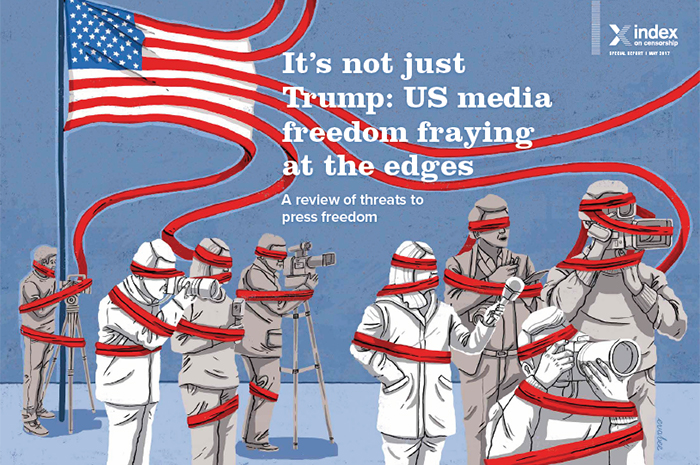
Smears about the media made by US President Donald Trump have obscured a wider problem with press freedom in the United States: namely widespread and low-level animosity that feeds into the everyday working lives of the nation’s journalists, bloggers and media professionals.
Index on Censorship published a report on media freedom in the US, documenting violations, limitations and threats to journalists from across the country in the six months leading up to the presidential inauguration and the months after. The research indicates that American media workers face pressure on a daily basis. Hannah Machlin, the project manager of Mapping Media Freedom, discusses how threats to US press freedom go well beyond the Oval Office.
Margaret Flynn Sapia spoke to Mapping Media Freedom Project Manager Hannah Machlin.
What is Mapping Media Freedom and how does it work? How does it relate to US Press Freedom Tracker?
Machlin: Mapping Media Freedom is a platform which documents all threats, violence and limitations to press freedom in Europe. The platform follows a strict two step Reuters-style verification system. For each reported incident, we require two to three independent sources which verify the location, subject matter and details of the censorship or confrontation. We gather this information by reviewing police statements, court documents and local news stories along with speaking to regional journalists. After the details have been verified, the report is edited for grammatical accuracy and clarity and is reviewed a final time by the project’s manager. The US Press Freedom Tracker also aims to track and analyse violations that are occurring in the United States.
What type of incidents does Mapping Media Freedom and the US press freedom tracker project cover?
Machlin: We report on a wide range of threats that affect journalists from doing their jobs such as violence, intimidation tactics and imprisonment. This also includes legislation and legal charges. Media professionals face dozens of hazards on a daily basis, so we do our best to cover any and all risks and retaliation they confront.
Do you include journalist related incidents even when they appear to be unrelated to the journalist’s work?
Machlin: If we can prove an incident is unrelated to a journalist’s work, it is not a fit for Mapping Media Freedom or the US press freedom tracker. However, journalists frequently face trumped up charges intended to silence or discredit them – like Canadian journalist Ed Ou who was detained at the US border without lawful reason on his way to cover a protest. Subsequently, we take extra care to review all of our reports on a case by case basis.
What are the most common difficulties you encounter in monitoring violations to press freedom?
Machlin: It’s difficult to depict an accurate image of the increasingly wide range of intimidation tactics used against journalists. For example, in the US, we documented that journalists have frequently been prevented from doing their job by government officials who have blocked reporting on President Trump’s campaign and various White House briefings. In addition to the onslaught of governmental targeting, the intimidation and attacks on media freedom are increasingly carried out by private individuals – either in person or online.
What most surprised you in Index’s report on US media freedom?
Machlin: The deterioration of press freedom in the US is nothing new. Under the Obama administration, a record number of whistleblowers were prosecuted and detained for their reporting. Moreover, we’ve seen rising levels of intimidation tactics used against journalists while reporting on demonstrations, including the Dakota Access Pipeline and the Black Lives Matter protests. Most recently, as the US Press Freedom Tracker reported, journalists were subjected to violence while covering protests in Charlottesville. Overall, threats to press freedom in the US are increasingly disturbing, and the US Press Freedom Tracker project’s goal is to continue shedding light on this increasingly disturbing trend and provide data for advocacy organisations.
Which findings of Index’s US media report do you think are most important?
Machlin: It doesn’t matter whether you are an independent reporter or an established news organisation – all American media workers face significant and undue risks on a daily basis. While freelancers traditionally lack the protection of established media outlets and thereby face a greater degree of risk, even large media organisations can be driven out of business if they rival the rich and powerful. This report has demonstrated that the threats to free media are deeply rooted.





